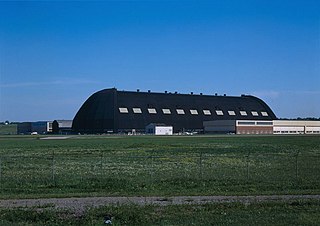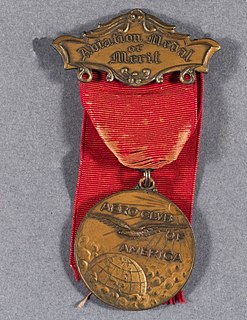
The Goodyear Blimp is any one of a fleet of airships operated by the Goodyear Tire and Rubber Company, used mainly for advertising and capturing aerial views of live sporting events for television. The term blimp itself is defined as a non-rigid airship – without any internal structure, the pressure of lifting gas contained within the airship envelope maintains the vessel's shape.

The J-class blimps were non-rigid airships designed by the Navy Bureau of Aeronautics and Goodyear Tire & Rubber Company in the early 1920s for the US Navy.
Goodyear Aerospace Corporation was the aerospace and defense subsidiary of Goodyear. The company was originally operated as a division within Goodyear as part of a joint project with Luftschiffbau Zeppelin, leading to the famous Goodyear Blimps. As part of the failing relationship between the US and Germany in the pre-war era, the division was spun off as Goodyear Aircraft Company in 1939. In 1941 they opened a new factory in Arizona where they produced subassemblies, including subcontracted airframe construction and the design of the Goodyear F2G Corsair and Goodyear Duck.

The Goodyear Airdock is a construction and storage airship hangar in Akron, Ohio.

Naval Air Station Rockaway adjoined Fort Tilden on the western portion of the Rockaway Peninsula in the New York City borough of Queens. It was established on transferred municipal property in 1917 during American involvement in World War I, and was demolished in 1930 to make way for Jacob Riis Park. Operations were moved across the inlet to a hangar in the municipal Floyd Bennett Field, which itself was sold to the federal government in 1941 and made Naval Air Station New York. NAS New York was decommissioned in 1972 and is now a part of the Gateway National Recreation Area, as are Fort Tilden and Jacob Riis Park.

Between 1908 and 1937 the U.S. Army had a program to operate airships. With the exceptions of the semi-rigid Roma and the Goodyear RS-1, they were non-rigid blimps. These airships were intended to perform search and patrol operations in support of coastal fortifications and border patrol. During the 1920s, the Army operated many more blimps than the U.S. Navy.

The B class blimps were patrol airships operated by the United States Navy during and shortly after World War I. The Navy had learned a great deal from the DN-1 fiasco. The result was the very successful B-type airships. Dr. Jerome Hunsaker was asked to develop a theory of airship design, Lt. John H. Towers had returned from Europe having inspected British designs, and using reports from attachés on British airship operations, the Navy was prepared to seek bids for blimps from American manufacturers. On 4 February 1917 the Secretary of the Navy directed that 16 nonrigid airships of Class B be procured. A February 12, 1917 meeting with the Chief of the Bureau of Construction and Repair, and representatives of Goodyear, Goodrich, Connecticut Aircraft Company, Curtiss Aeroplane and Motor Corporation, and U.S. Rubber Company, it was agreed that the order for 16 dirigibles was beyond the capability of any one company. The conference resulted in a committee to coordinate on sharing raw materials, information and experience. Ultimately Goodyear manufactured 9 envelopes, Goodrich made 5 and Curtiss assembled the gondolas for all of those 14 ships. Connecticut Aircraft contracted with U.S. Rubber for its two envelopes and with Pigeon Fraser for its gondolas. The Curtiss-built gondolas used by Goodyear and Goodrich used modified Curtiss JN-4 fuselages powered by Curtiss OXX engines. The Connecticut Aircraft blimps were powered by Hall-Scott engines. One ship, B-20 was equipped with a special control car. All B-Class airships were delivered to the Navy between August 1917 (B-1) and September 1918 (B-20).

The D class blimp was a patrol airship used by the US Navy in the early 1920s. The D-type blimps were slightly larger than the C-type and had many detail improvements. The Navy continued the practice of dividing the envelope production between Goodyear and Goodrich. The control cars were manufactured by the Naval Aircraft Factory. The major improvements over the C-type blimps were a better control car design and easier, more reliable controls and instrumentation. The engines were moved to the rear to reduce noise and allow better communications between crew members. The fuel tanks were suspended from the sides of the envelope. The envelope was identical to the C-type, except an additional six-foot panel was inserted for a total length of 198 feet (60 m) and a volume of 190,000 cubic feet (5,400 m3). The last of the D-Class, D-6, had a different control car designed by Leroy Grumman who later founded the Grumman Aircraft Engineering Corporation.

The Wingfoot Air Express was a dirigible that crashed into the Illinois Trust and Savings Building in Chicago on Monday July 21, 1919. The Type FD dirigible, owned by the Goodyear Tire and Rubber Company, was transporting people from Grant Park to the White City amusement park. One crew member, two passengers, and ten bank employees were killed in what was, up to that point, the worst dirigible disaster in United States history.

Hangar No. 1 is an airship hangar located at Naval Air Engineering Station Lakehurst in Manchester Township, in Ocean County, New Jersey, United States. It is best known as the intended destination of the rigid airship LZ 129 Hindenburg prior to the Hindenburg disaster on May 6, 1937, when it crashed and burned while landing.
Airship hangars are specialized buildings that are used for sheltering airships during construction, maintenance and storage. Rigid airships always needed to be based in airship hangars because weathering was a serious risk.

The Goodyear GZ-20 was a blimp class introduced in 1969 in the United States by Goodyear as its signature promotional aircraft, the Goodyear Blimp. The design is a development of the GZ-19 class, featuring a larger envelope to carry the "Super-Skytacular" night sign and more powerful engines. The GZ-20s were an active member of Goodyear's airship fleet until 2017.

Thomas Greenhow Williams "Tex" Settle was an officer of the United States Navy who on November 20, 1933, together with Army major Chester L. Fordney, set a world altitude record in the Century of Progress stratospheric balloon. An experienced balloonist, long-time flight instructor, and officer on the airships USS Shenandoah (ZR-1) and USS Los Angeles (ZR-3), Settle won the Litchfield Trophy in 1929 and 1931, the International Gordon Bennett Race in 1932, the Harmon Aeronaut Trophy for 1933, and the Harmon National Trophy for 1932 and 1933. He also set numerous distance and endurance records.
In the nation's quest to provide security along its lengthy coastlines, air reconnaissance was put forth by the futuristic Rear Admiral William A. Moffett. Through his efforts, two Naval Air Stations were commissioned in the early 1930s to port the Naval Airships (dirigibles) which he believed capable of meeting this challenge.
Unlike later blimp squadrons, which contained several airships, the large rigid airship units consisted of a single airship and, in the case of the USS Akron and USS Macon, a small contingent of fixed-wing aircraft.

The Akron-class airships were a class of two rigid airships constructed for the US Navy in the early 1930s. Designed as scouting and reconnaissance platforms, the intention for their use was to act as "eyes for the fleet", extending the range at which the US Navy's Scouting Force could operate to beyond the horizon. This capability was extended further through the use of the airships as airborne aircraft carriers, with each capable of carrying a small squadron of aeroplanes that could be used both to increase the airship's scouting range, and to provide self-defense for the airship against other airborne threats.




















